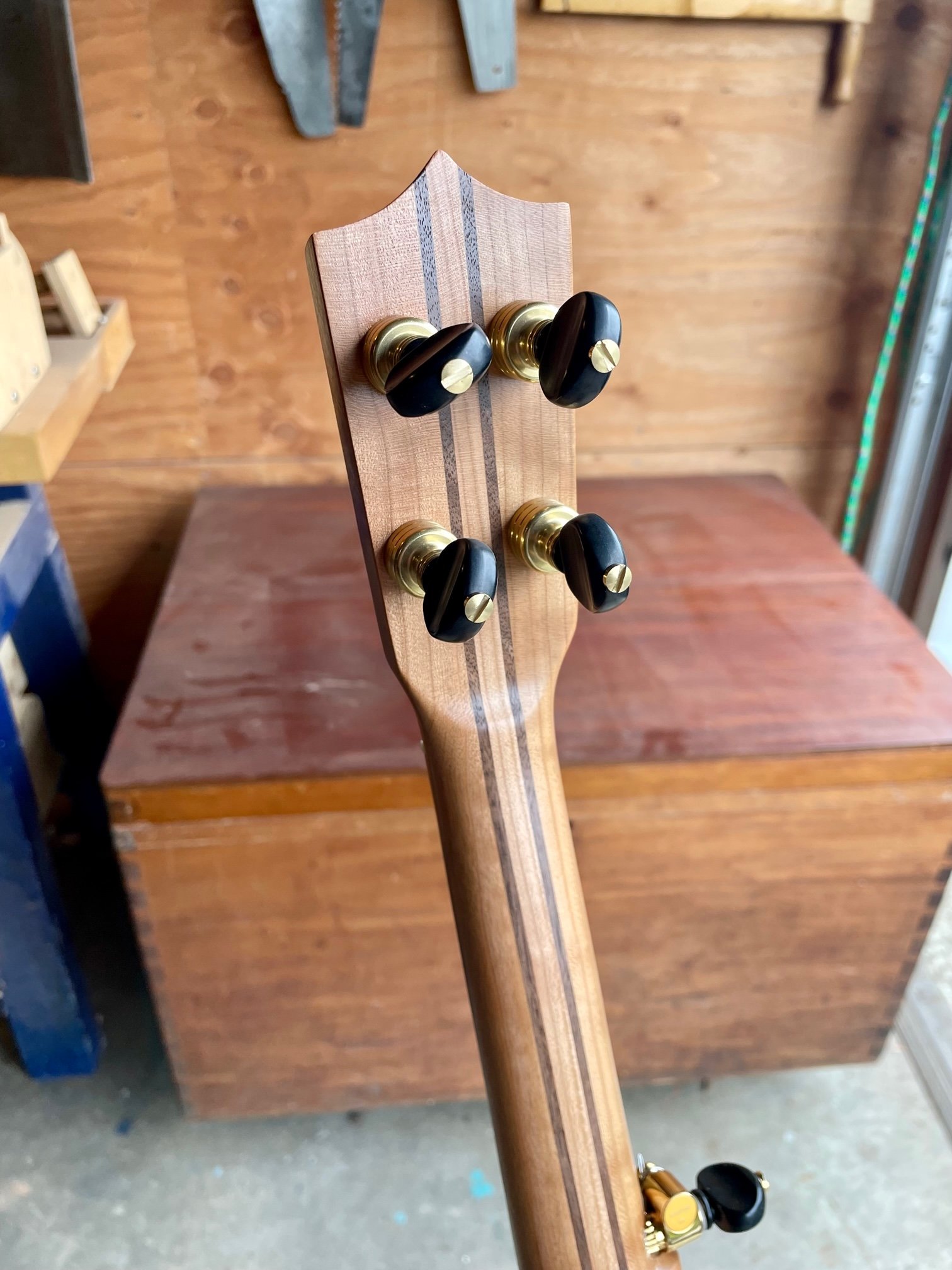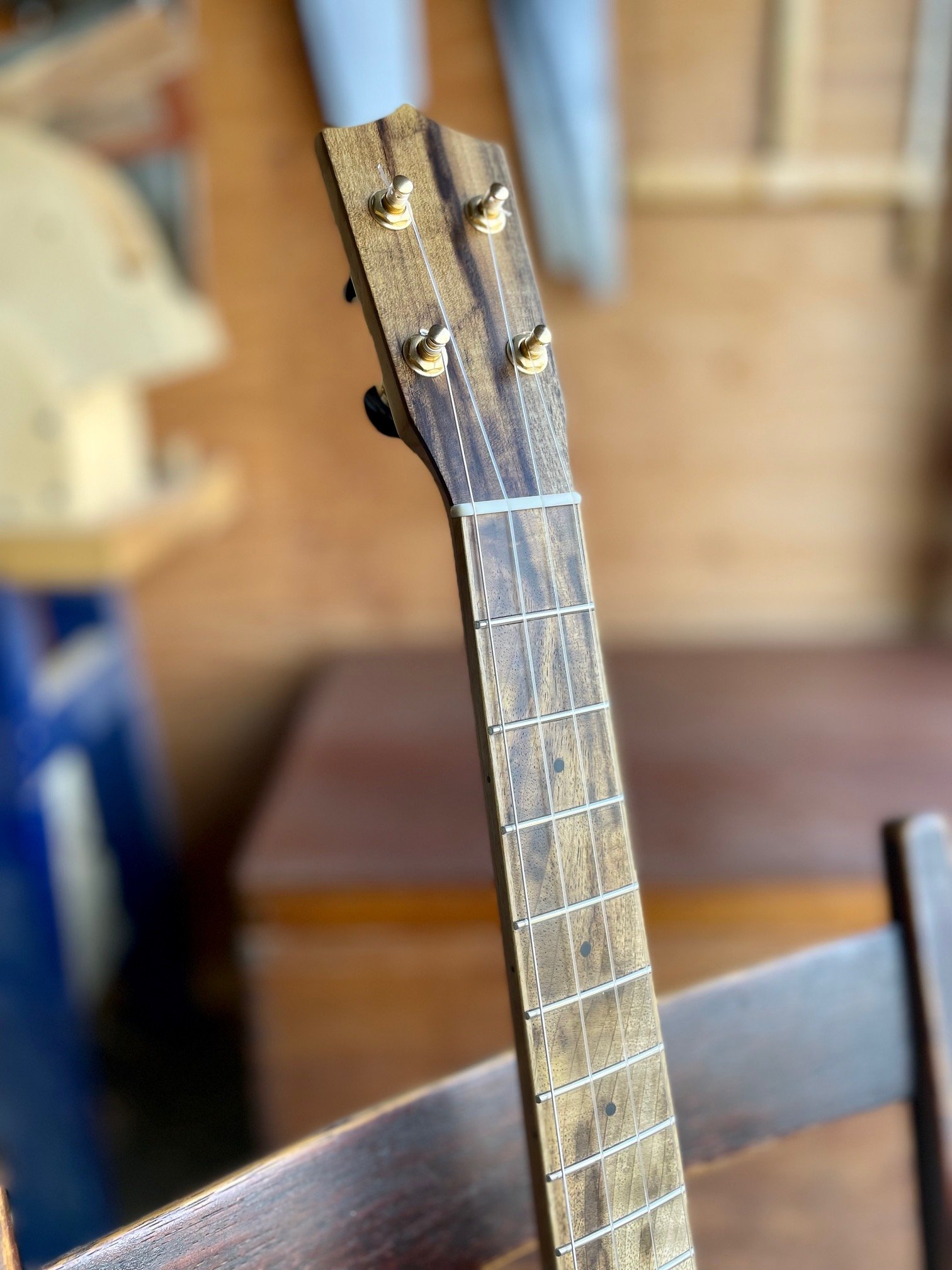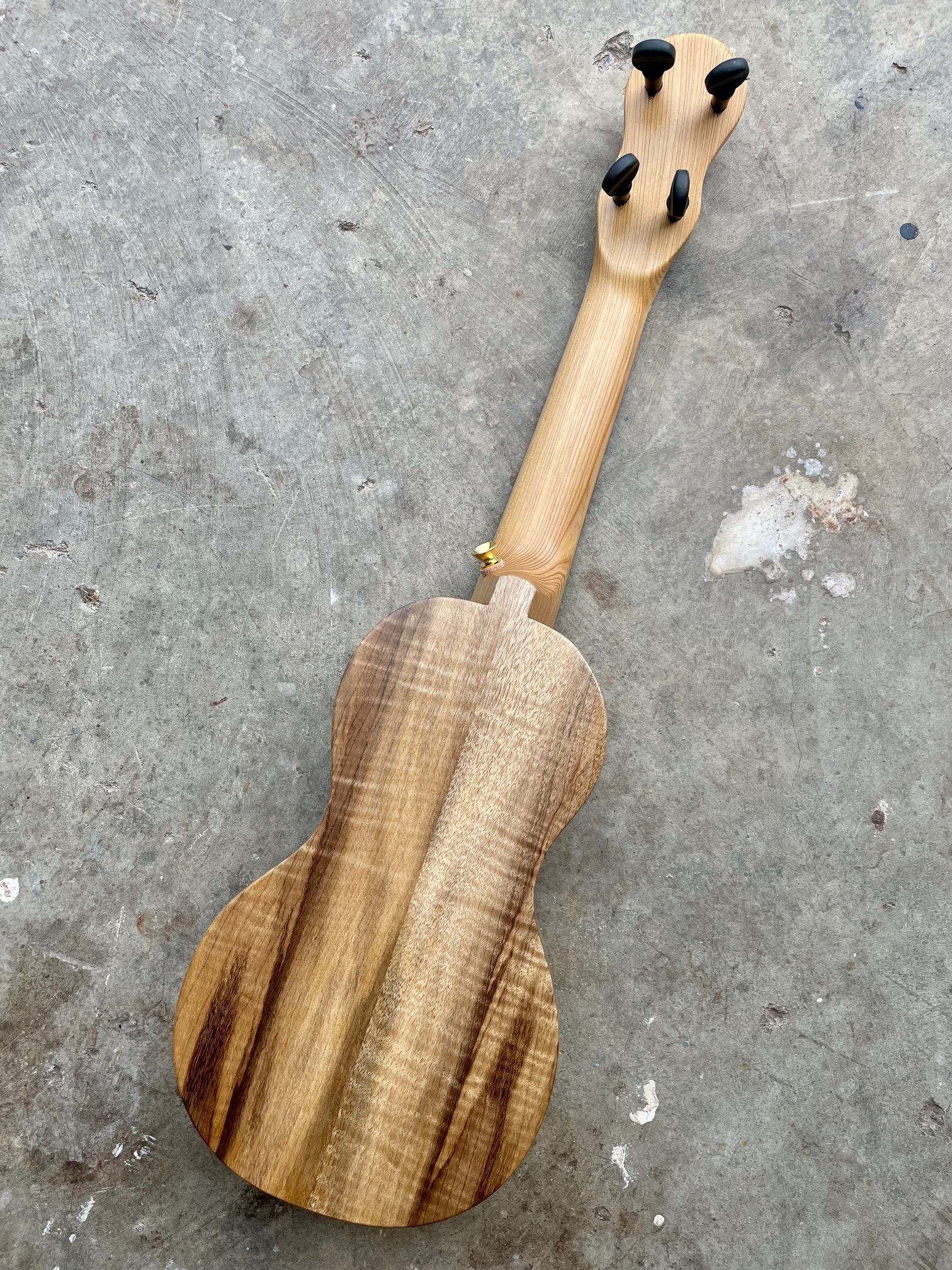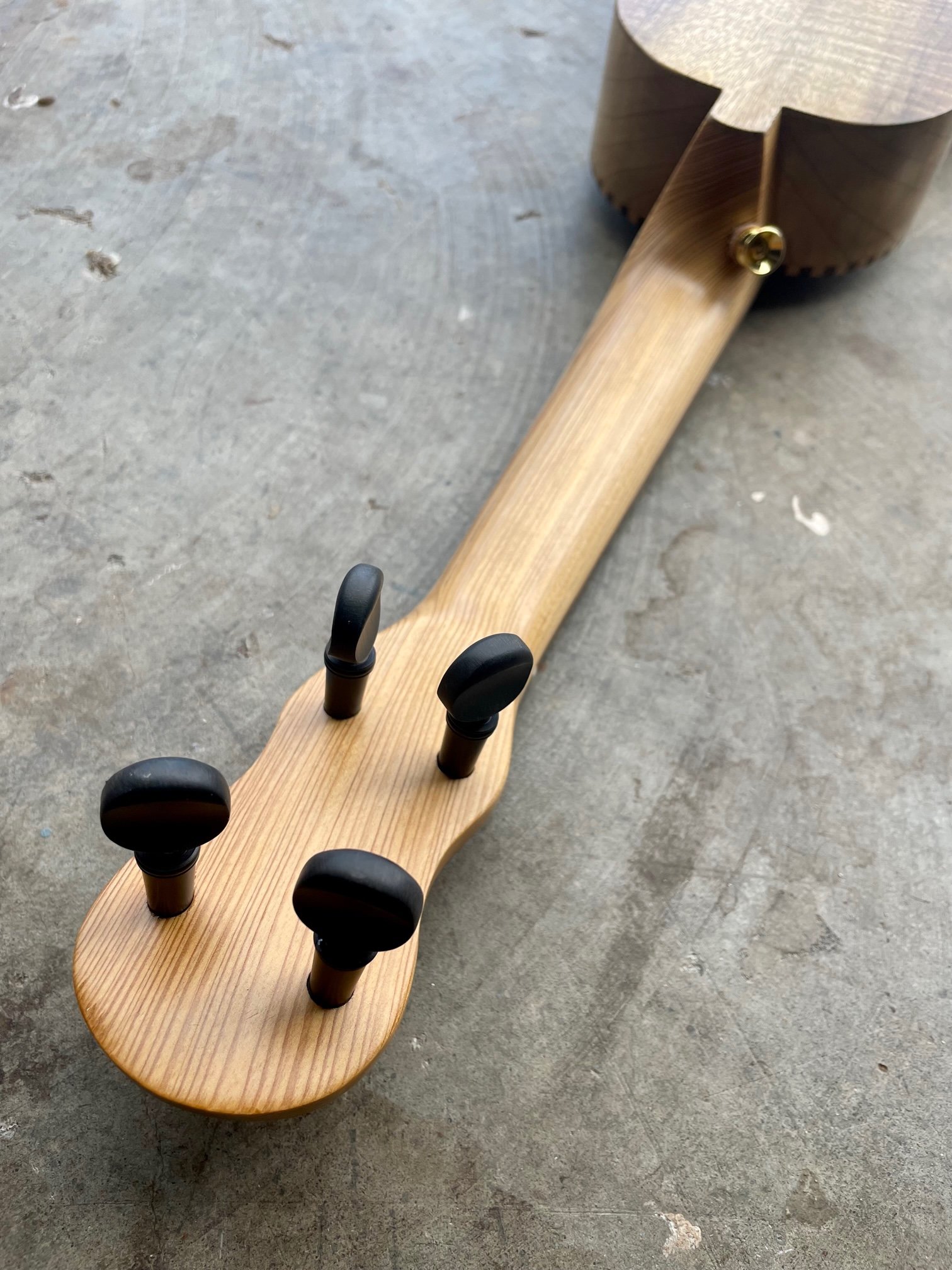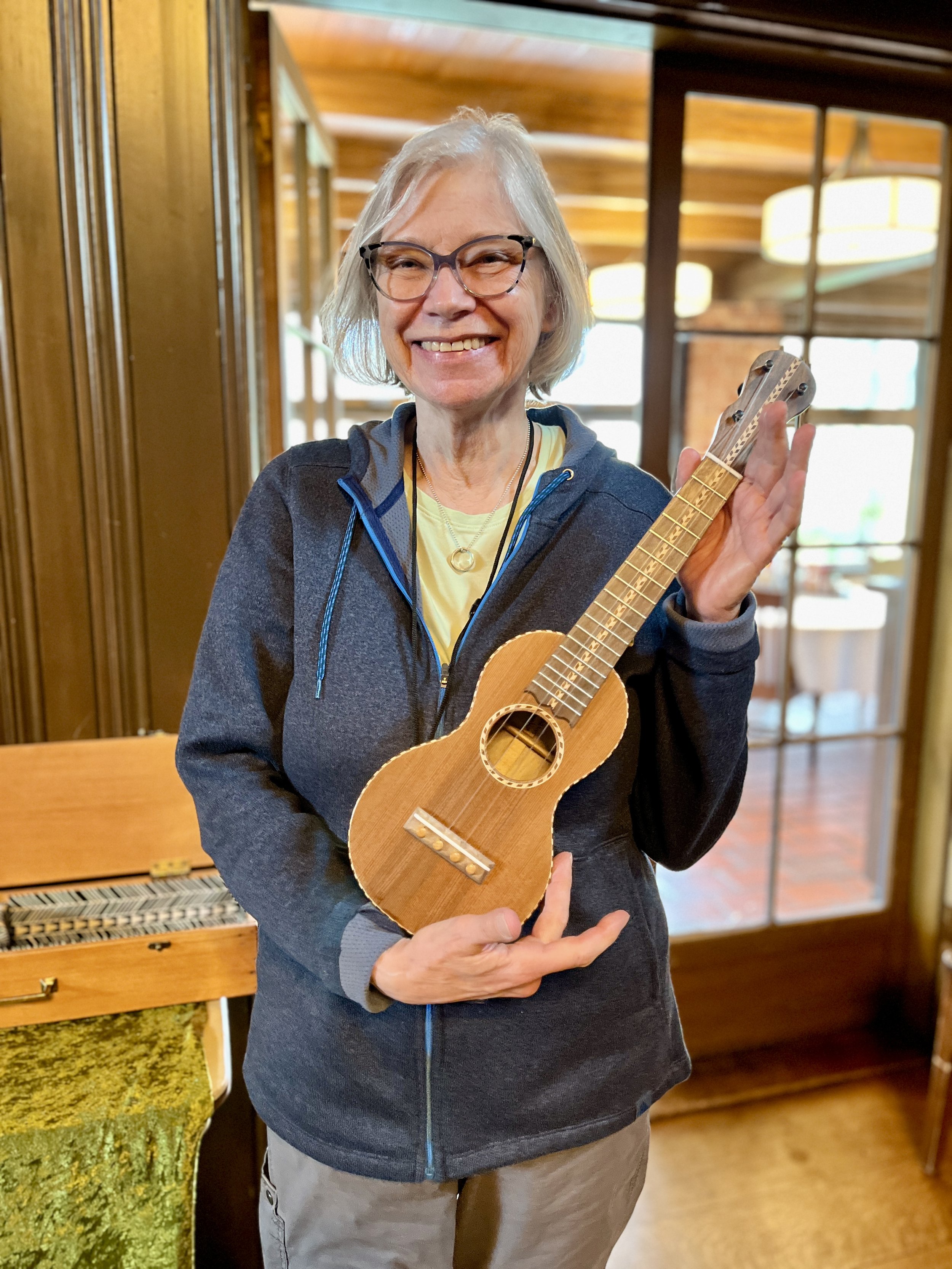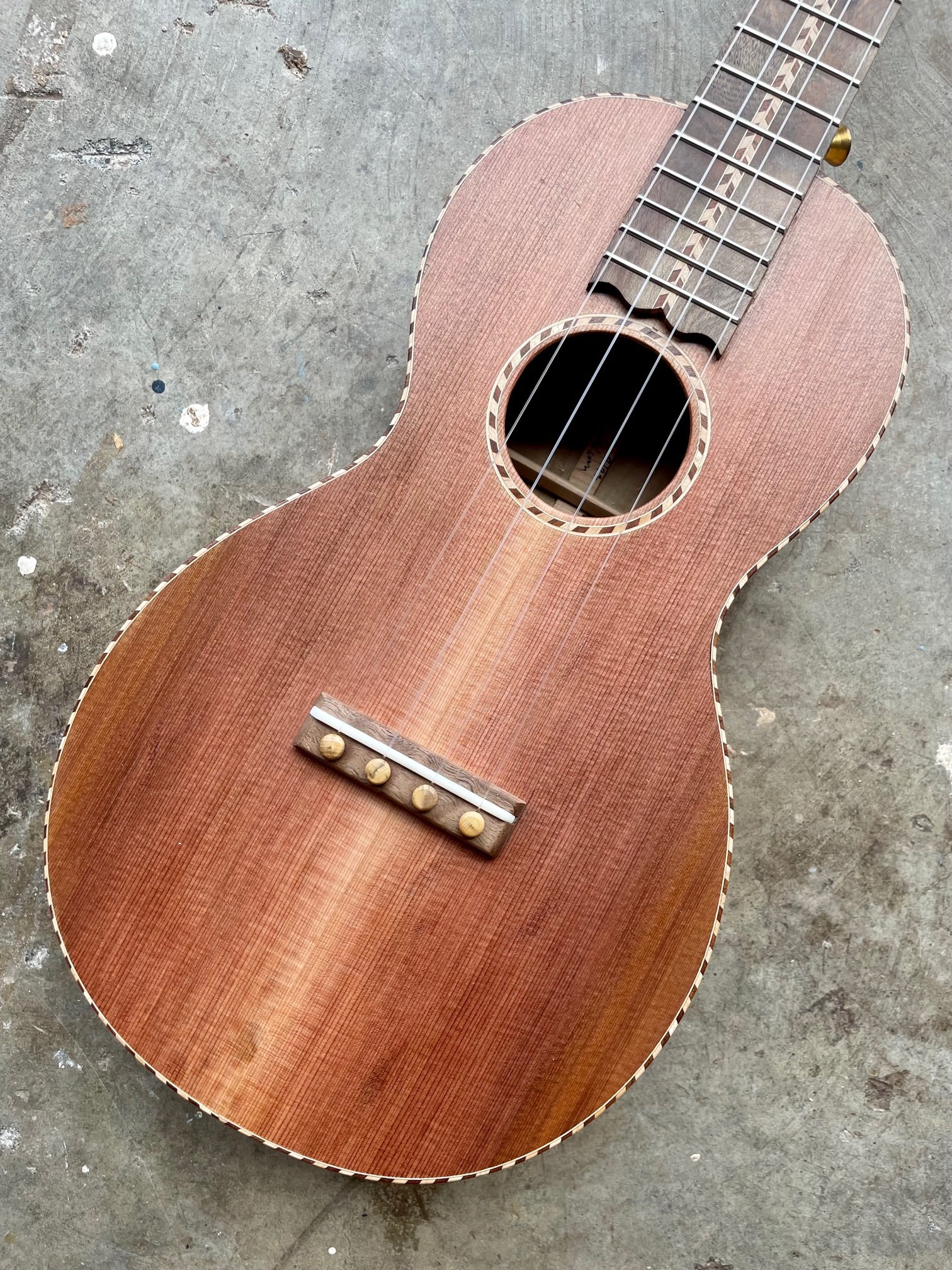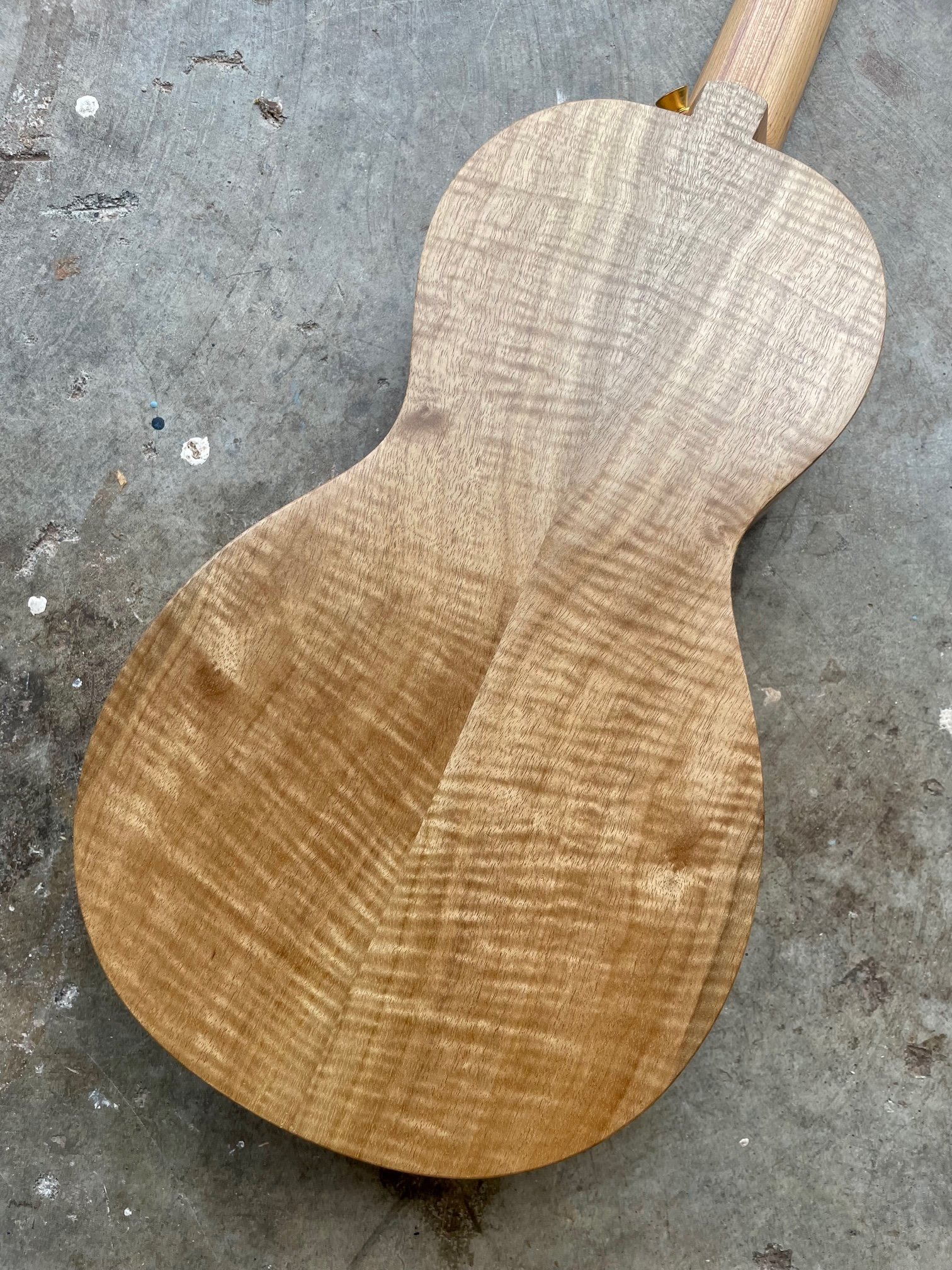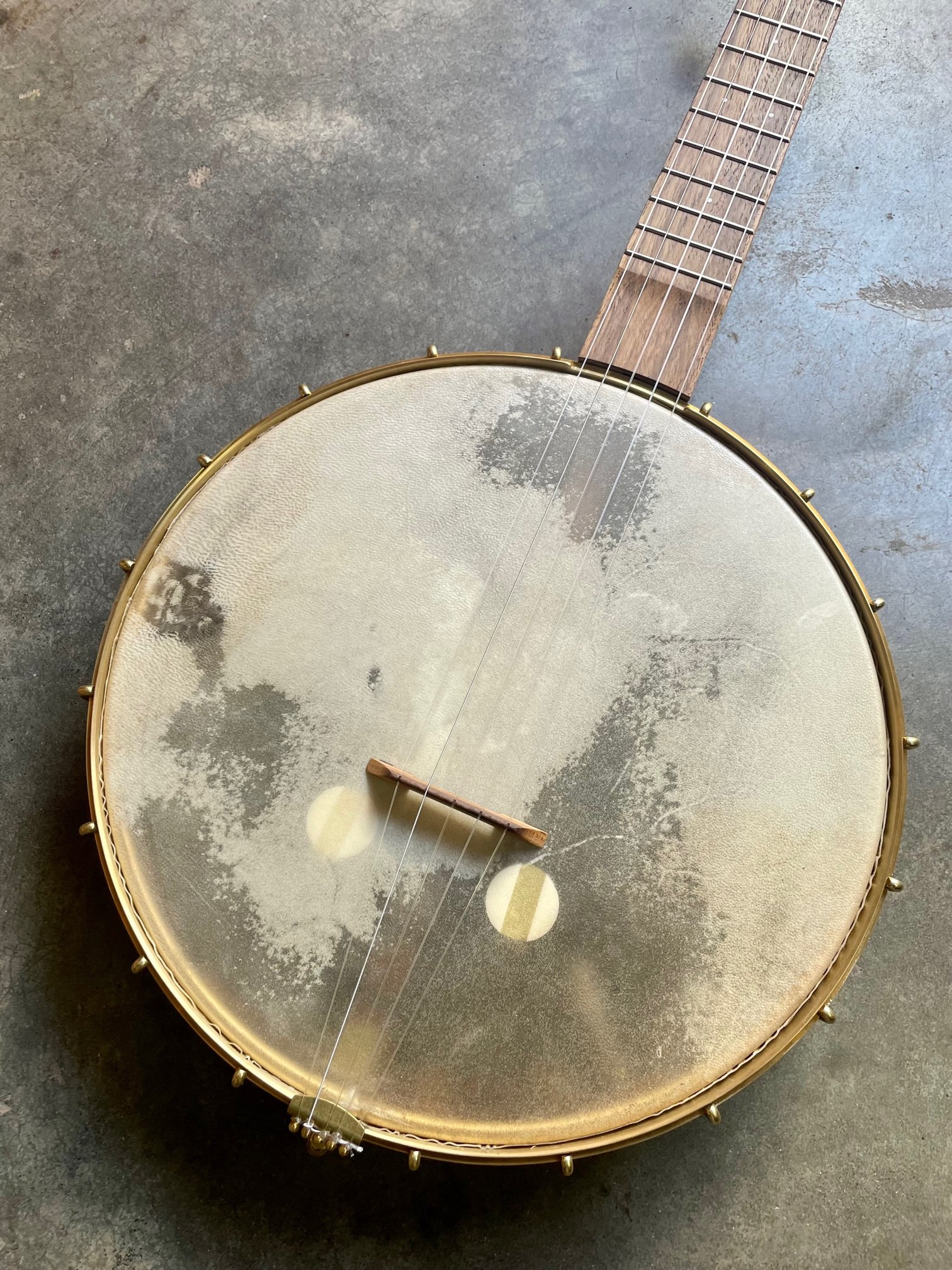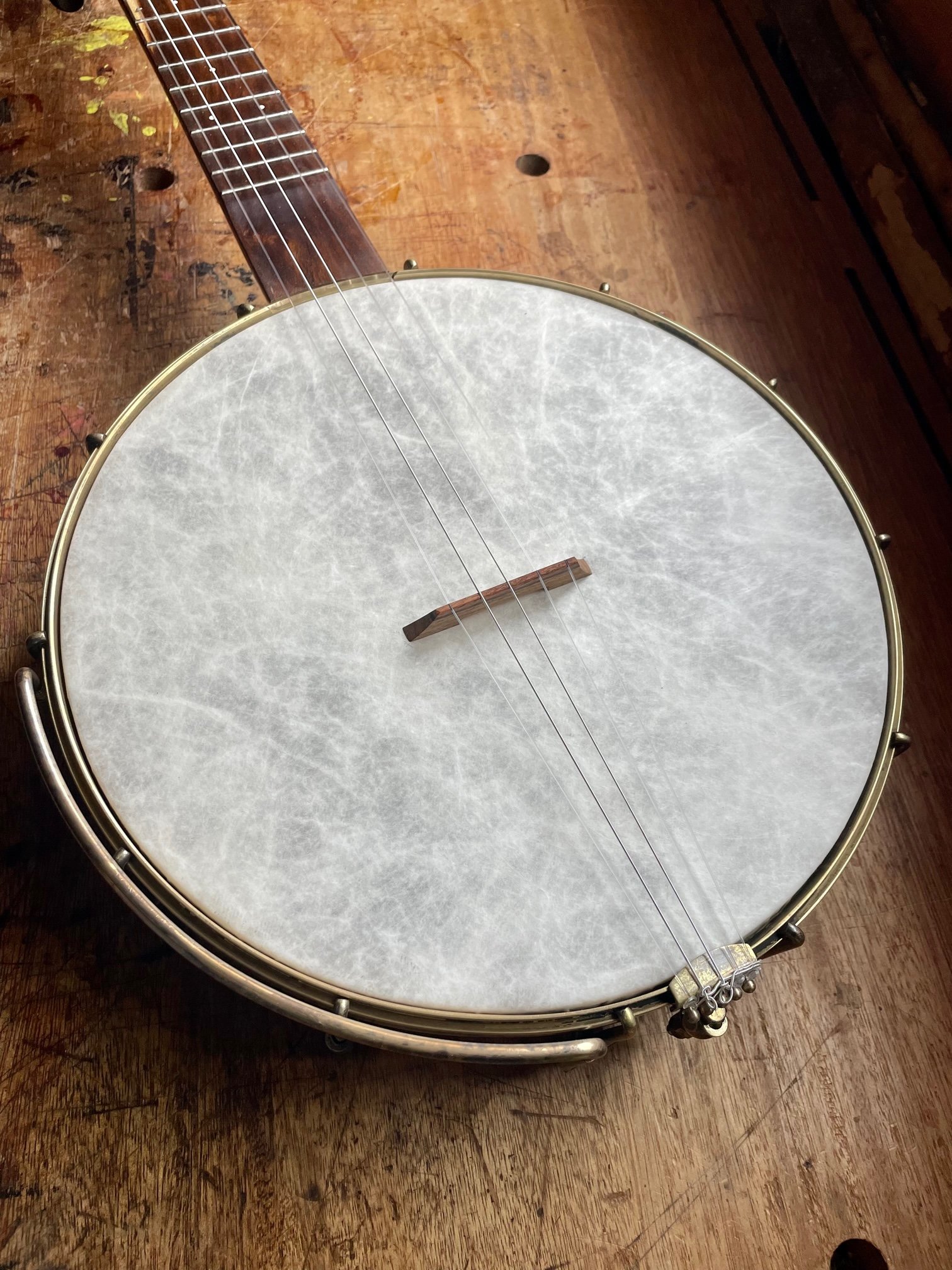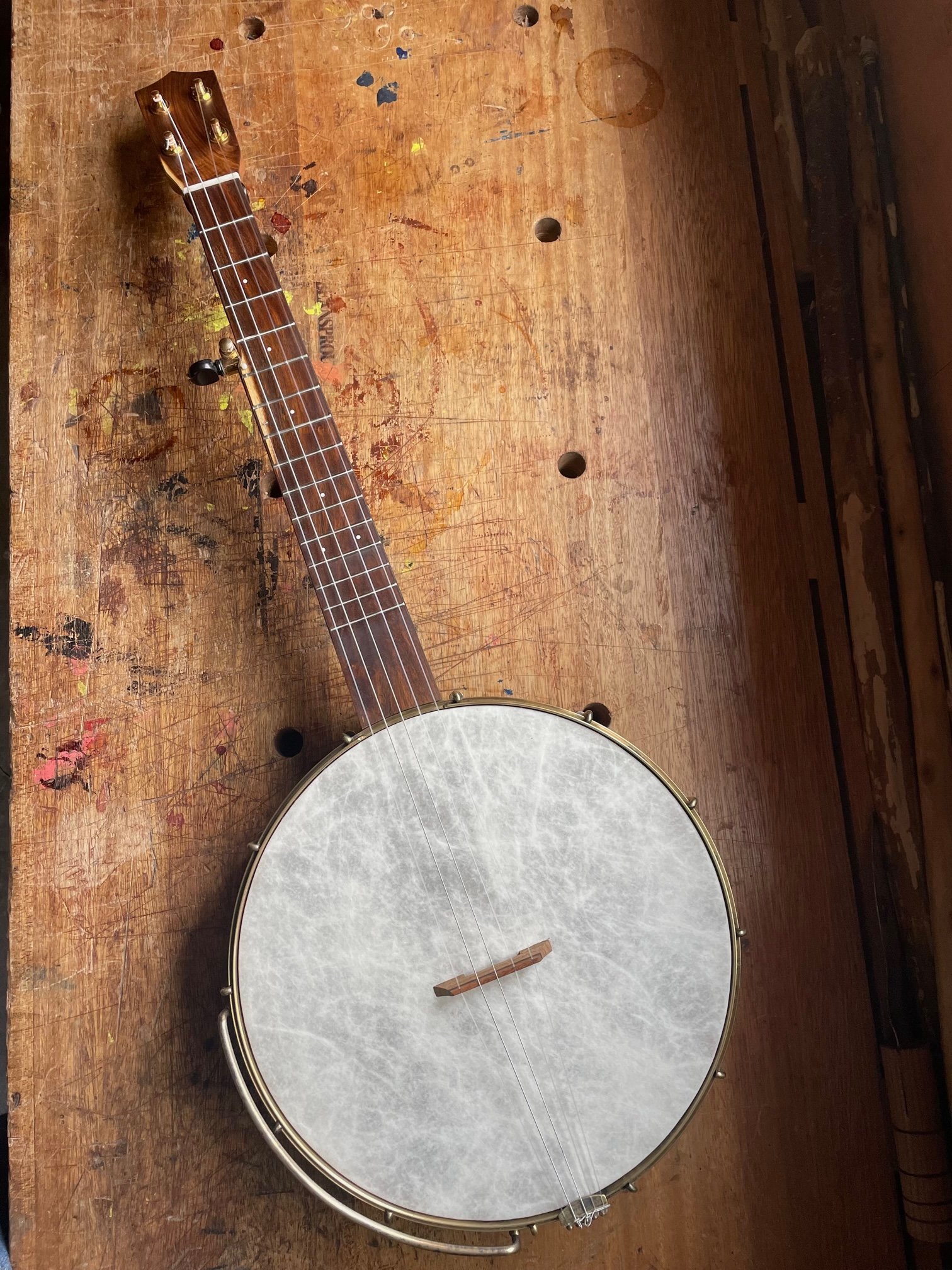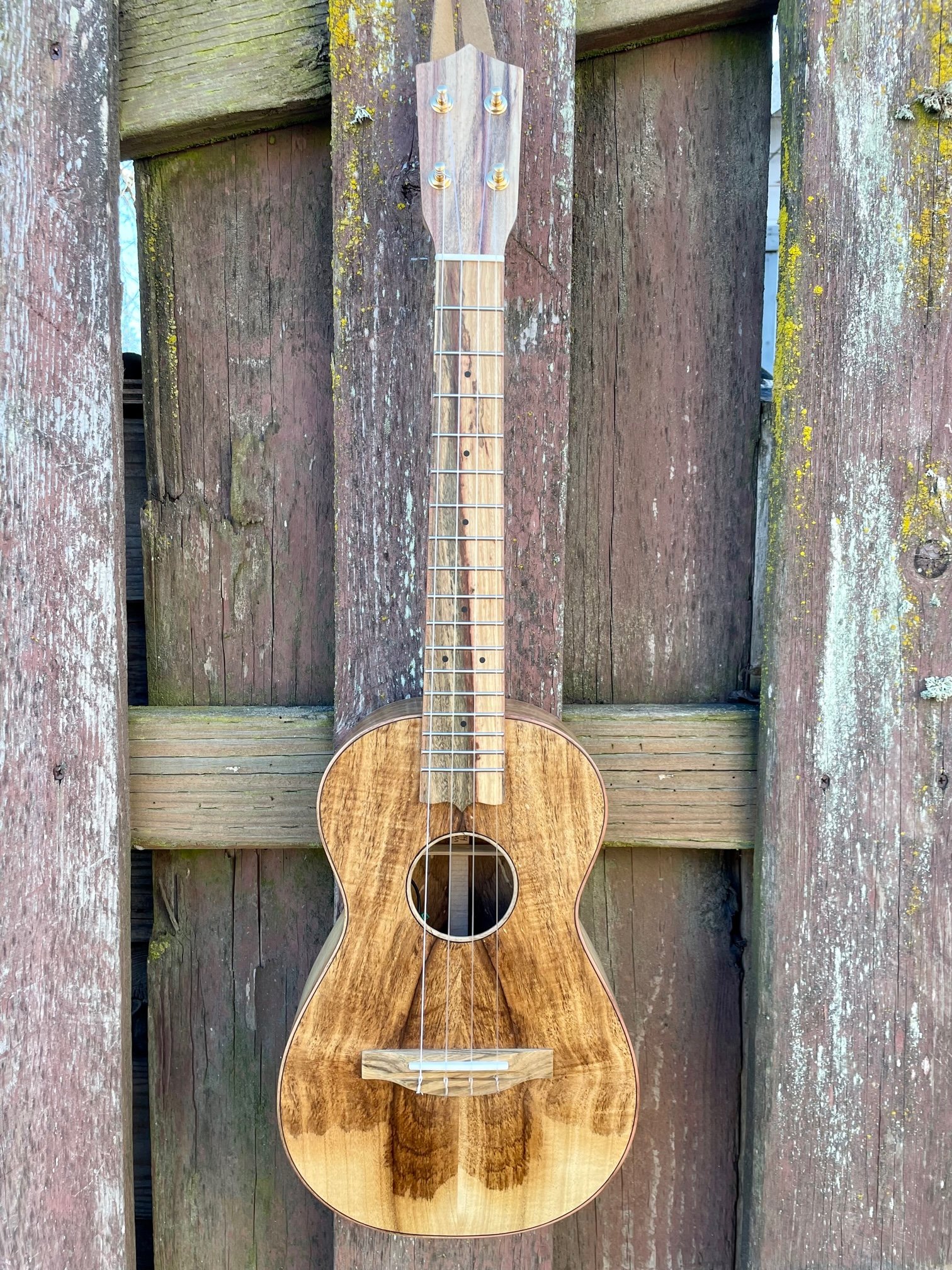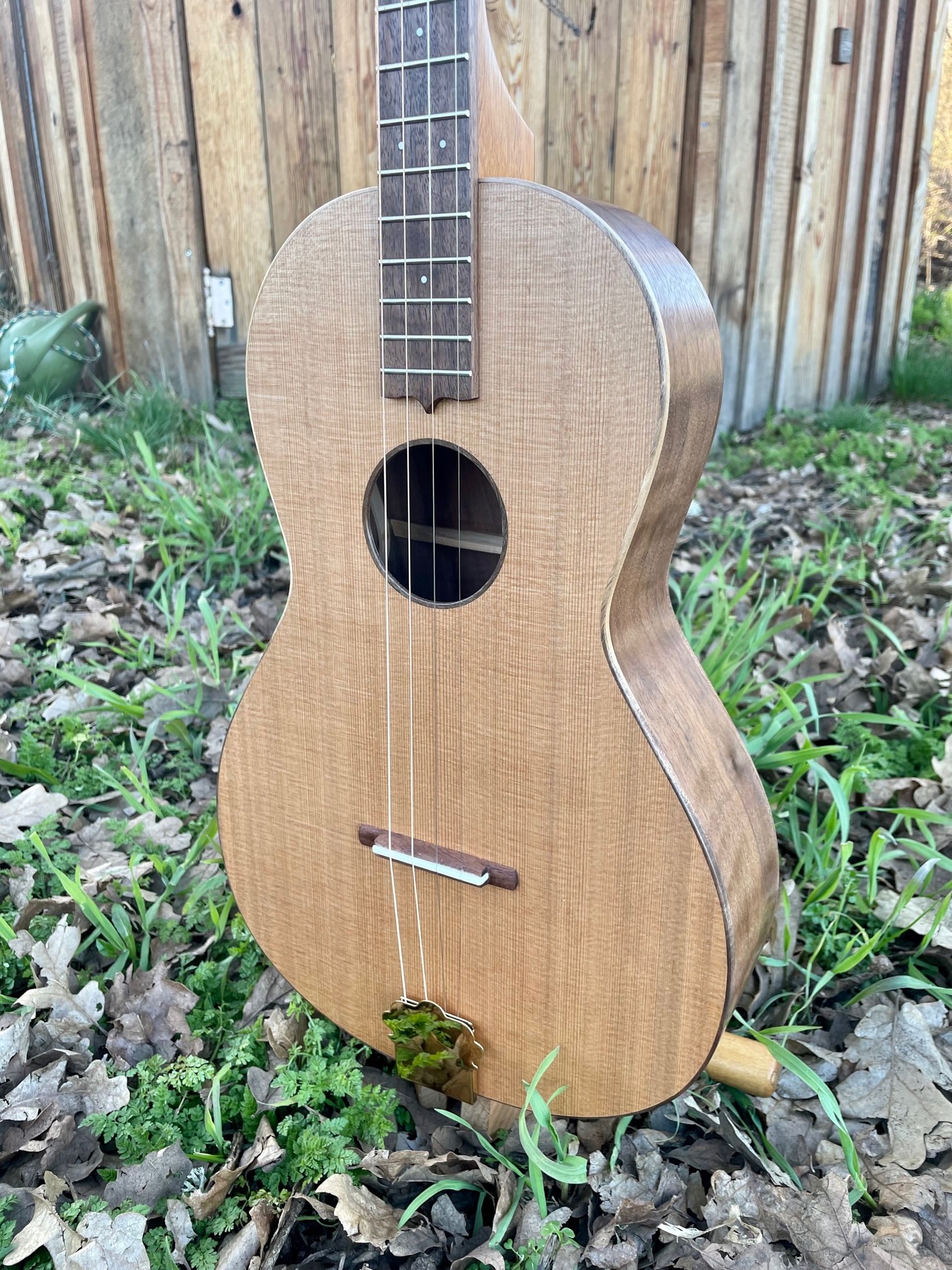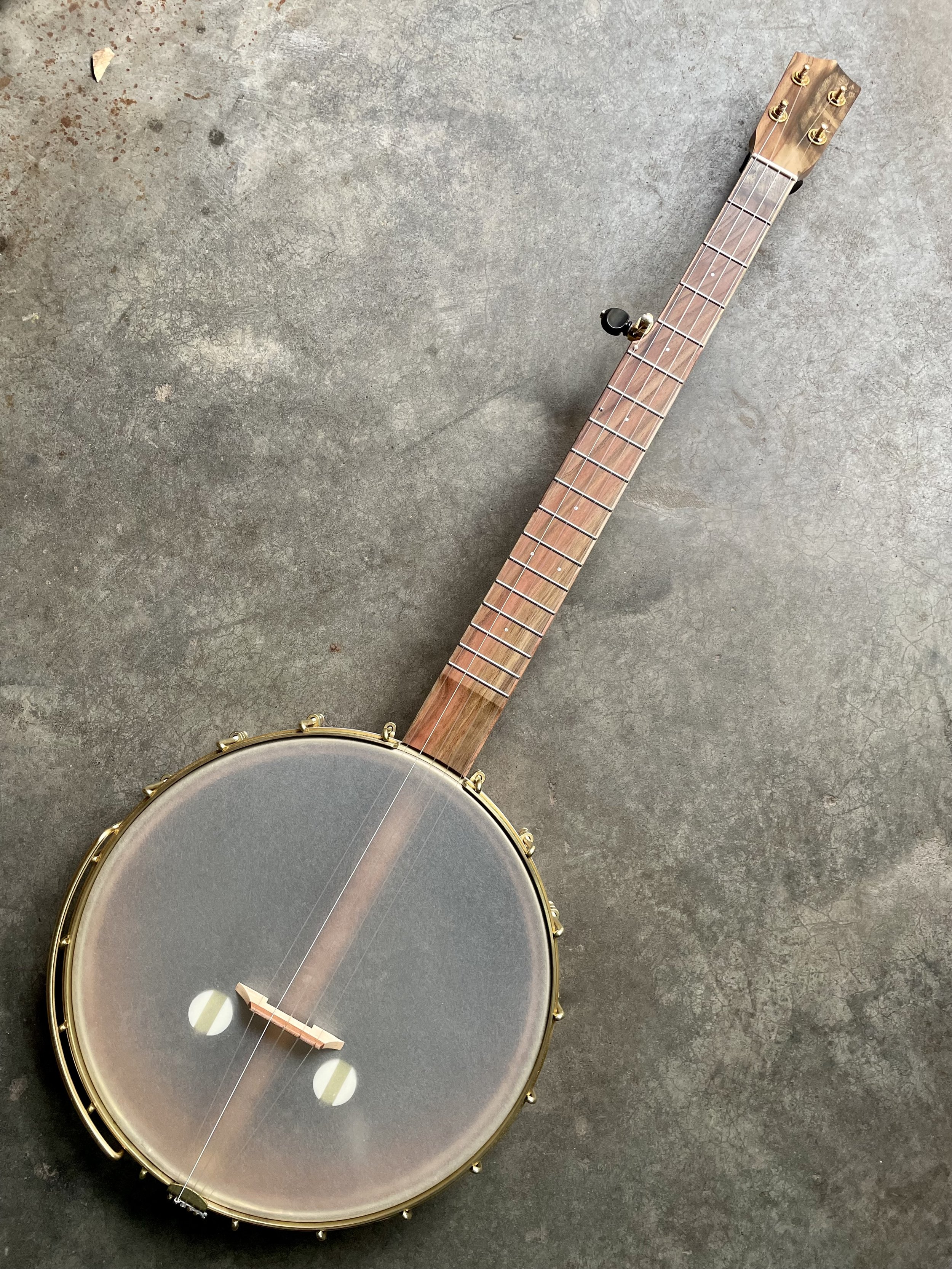I love finding new domestic woods! In this case, I found some Monterey Cypress that I got in trade from another builder. It is from Monterey Bay California, of course. This is a soft wood that seems almost as stiff as spruce, but has a glassy quality that led me to choose it for the back and sides as well. This isn’t without precedent, as Cypress is used for back and sides in Spain. I bound it in Walnut for some contrast and chose Dogwood for the rest from the Carpenter Ant stash in Portland. It is light, cheerful and sweet and I’m darn proud of it.
#898- Curly Cherry and Pistachio Five String Banjo
I think Cherry is a great banjo wood, confidently placed between Walnut and Maple. Plenty loud, but a little sweet, with a growl to the low string. This one has a goat skin head, brass tone ring, arm rest, Pistachio trim and a little sprout inlay on the headstock. The Cherry comes from the Carpenter Ant stash in Portland and the Pistachio comes from California orchards.
“Good evening, Aaron and Nicole,
Just wanted to tell you that I’ve been playing #898 a lot. Aside from its visual beauty and lovely tone, it’s the most comfortable banjo I’ve ever played, and has proven to be a huge hit around here. Everyone who has seen or heard it has been vocally (and as nearly as I can tell, sincerely) impressed.
In short, I love it.
All the best,
- J. L. ”
#896- Redwood and Dogwood Scout Ukulele
Dogwood is a multicolored hardwood that we see quite a bit in the NW, but it rarely gets big enough for woodworking. This Dogwood back and sides came from a tree at our friend Lizann’s house which her father milled many years ago. It pairs perfectly with the striped Redwood, which is the scrap left from a guitar top. The neck is some salvaged Douglas Fir and the rest is local Walnut. It is sweet and dusty, a joy to play. Thanks Jason!!!
#892- Port Orford Cedar and Walnut Scout Ukulele
I make these Scout ukuleles when I have the extra time, from scrap wood from other projects. Basically I have a couple of bins of suitable materials that I choose from, letting each piece lead me to the next. For this uke, my son Henry chose everything. Curly Port Orford Cedar top, Walnut back/sides/headplate/bridge, Red Cedar neck, Oak fretboard and body binding. I tried out some little, nickel Grover geared tuners and matched them to some nickel strap buttons. They are lightweight, work great and suit the price point for this little uke. It is bright and cheerful, with a surprising amount of sustain.
To join our scout waiting list, please email Nicole at info@thebeansprout.com
“Hello Keims!
The little Scout has arrived! And I absolutely love it. The woods are truly beautiful - the colors, the grains, the trims. Such a lovely choice of woods, Henry. The tone is sweet, bright and full. Aaron, it is truly a delight to have this little ukulele. And a pleasure to support your endeavors. And I love that it is built from scraps in your shop. Here’s a little video of me playing a little tune I wrote — “Zoe’s Shuffle” (for our cat, Zoe).
Many thanks and all the best to you, Nicole and Henry.
What a great gig bag too!
- P. S.
”
#897- Yellow Cedar and Sycamore Tenor Ukulele
This instrument is a tenor version of an alto ukulele that I already built for this customer. It sounds full and bright, with a springtime cheerfulness that feels good today. The Sycamore back and sides are from the Carpenter Ant stash in Portland. The yellow Cedar top and the Port Orford Cedar neck came from my neighbor, a retired flute maker. It is tied together with local Walnut fretboard, headplate, bridge and binding. The customer requested an amber tint to everything, which makes it look old and a little rustic. I appreciate every customer, but repeat customers always make me feel extra thankful. Thanks for keeping the lights on, Don!
“Dear Aaron and Nicole,
The beautiful sycamore, Alaska cedar, walnut, and Port Orford Cedar/walnut neck #897 was delivered today. I could not be more pleased with its appearance and its out of the box tone. You did a wonderful job blending the tinting of the exceptionally tightly grained sycamore back and sides with the old and figured Alaska cedar and Port Orford neck.
Thank you for the elegant walnut face plate and for carefully matching the arc of the walnut figuring in the fretboard with the sweep of the grain in the cedar.
What great tone this tenor has all the way up and down the fretboard! It’s easy to play with a light touch, with warm mid tones and deeper bass resonance on the C string with only a little more pressure. The sustain is loooonnnng! And there are overtones as a bonus.
You’ve made another singing Beansprout ukulele, Aaron, and I look forward to playing it for years to come.
Best regards,
D. H.
”
#895- Mastergrade Myrtle Baritone Ukulele
All Myrtle instruments are always a favorite of ours. It feels like our Koa, as it comes from Oregon. This particular mastergrade set came from luthier Jayson Bowerman, as it was too small to use for his guitars. It also has Myrtle binding, fretboard, headplate and bridge! The neck is salvaged fir, with some evidence of its past life as a floor joist. It is strung gcea, which is a fresh sound when you are expecting the more common dgbe range. It has a 1.5” nut width and a K&K pickup as well. It’s off to a repeat customer. Cheers Tom!
#899- Maple and Texas Ebony Tenor Banjo Ukulele
This banjo looks simple and classic to me, with an attitude that seems older than it really is. The maple is all cutoffs from other banjo projects and the Texas ebony is from a retired builder’s shop. It is finished with Amber shellac and wax, which is a little glossier than I usually do, but adds to the antique feel. It is loud, poppy and easy to play. I hope Melissa loves it. She’s an amazing person and friend and I’m honored to have built this for her.
#860- Cedar and Myrtle Kingdom Era Soprano Ukulele
This soprano ukulele grew out of my research into historic Hawaiian instruments of the 1880-1890’s. My model is based on an instrument called the Machete, a 4 string folk instrument that the first luthiers brought from Madeira. The scale length is 13.5” and the original tuning was dgbd, which changed over time to our familiar gcea. I used the tools, techniques and materials of the original builders with a few modern improvements. This is not a copy of one builder’s work, but instead my own design inspired by their output.
The top is Western Red Cedar from near Bend, OR, provided by luthier Jayson Bowerman. The curly Myrtle is from the Oregon Coast, from Kevin at woodfromthewest.com. The Walnut fretboard/headplate/bridge is from a local tree that I milled. The Cypress neck was salvaged from a factory tank. It has modern, geared Peghed brand tuners, modern frets in a flat fretboard, gut strings, bone nut and saddle and hand rubbed oil finish. It comes with a handmade wooden case, based off the originals, made from salvaged Fir and lined with cloth.
#861- Cedar and Myrtle Kingdom Era Tenor Ukulele
This tenor ukulele grew out of my research into historic Hawaiian instruments of the 1880-1890’s. My model is based on an instrument called the Rajao, a 5 string folk instrument that the first luthiers brought from Madeira. The scale length is 17” and the original tuning was dgcea, which includes our familiar gcea. For this build, I chose to just use four strings and call it a tenor ukulele, although I retain the body shape and size of the historic Rajao. I used the tools, techniques and materials of the original builders with a few modern improvements. This is not a copy of one builder’s work, but instead my own design inspired by their output.
The top is Western Red Cedar from near Bend, OR, provided by luthier Jayson Bowerman. The curly Myrtle is from the Oregon Coast, from Kevin at woodfromthewest.com. The Walnut fretboard/headplate/bridge is from a local tree that I milled. The Cypress neck was salvaged from a factory tank. It has modern, geared Peghed brand tuners, modern frets in a flat fretboard, fluorocarbon strings, bone nut and saddle and hand rubbed oil finish. It comes with a handmade wooden case, based off the originals, lined with cloth and made from salvaged Hemlock.
The price is $3000 including the case, plus shipping. It’s available for purchase here.
***** If you are an international customer (outside of the US), please note we may need to charge you additional shipping fees depending on your location. You will also be responsible for any customs fees imposed by your country. Thanks! ******
#885- Toon (Australian Cedar) Tenor Ukulele
Toon is an Australian wood that is an invasive species in Hawaii. I was given some by Casey, one of the caretakers of Ho’oulu ‘Āina, a 100 acre nature preserve dedicated to food, medicine, housing and community on Oahu. Toon is also called Australian Cedar or Australian Mahogany and I think it works and sounds like a combination of the two. It makes a lightweight, resonant and beautiful ukulele that is a good alternative to Koa. Since it is invasive, removing it helps the native forest and building from it is a responsible choice. There are many bug holes in this board, including a prominent one between the sound hole and the bridge, which I think adds character to this unique instrument. I paired the Toon with a scrap wood Mahogany neck and some local Walnut. A portion of this sale will go to Ho’oulu ‘Āina. I will add some pictures below of forester Bart Potter, who first started milling these logs on Oahu.
“Hi Aaron and Nicole!
The ukulele arrived today in perfect condition. I was absolutely blown away with the beauty of this instrument when I opened the case! It sounds utterly incredible, so warm, punchy, balanced, and rich. The playability is off the charts too, it practically plays itself. It’s so easy to finger even complex chords.
I particularly love playing fingerstyle and this instrument is so touch sensitive and dynamic, it really responds like no other to light, medium, or harder playing. I love that! My wife plays piano and was completely floored by the quality of sound that comes out of this little guy. We love it. I’ve owned more instruments than I can remember including guitars, basses, drums, etc. and this ukulele is the best of them all, at least in my hands.
This one will be passed down to my kids when the time comes. You guys are at the top of your game and the sound, build quality, and uniqueness of your instruments is unmatched. I truly appreciate you and what you do.
BTW: How did you get it to smell so wonderful? It smells like some kind of flowers to me.
Thank you again!
- C. T.
”
#890- Walnut and Pistachio Five String Banjo
Another banjo inspired by one of our old friends and artists, Steve Varney. 12” walnut rim, brass tone ring, Fiberskyn head and a rich but vibrant sound. The fretboard is a unique piece from a California orchard, with some beauty marks that keep me humble. The rest is Walnut and Cherry from the Carpenter Ant stash in Portland. The customer wanted some extra frets instead of a scoop, no problem.
#889- Walnut and Teak Five String Banjo
A Walnut five string banjo with a 12” rim has become a popular model for us. The secondary wood, used for fretboard and trim, is often Pistachio. In this case we used some salvaged Teak from the Carpenter Ant stash in Portland. It is smooth and glassy and just hard enough for a banjo or uke fretboard. I wouldn’t buy this tropical wood new, but these salvaged scraps are fair game. The walnut is from Oregon. The skin head, non-steel strings and brass tone ring make a mellow but strong sound. A little leaf inlay with an important name wood burned into it by Nicole seals the deal.
“Hey guys,
I’m absolutely blown away with how it turned out. I know I might have been a bit unconventional during the design process, but you both did an incredible job. Thank you both so much for doing the inlay...... it really means a lot and hopefully one day Nora will want to play and have it :)
- K. M. ”
#891- Curly Cherry and Texas Ebony Short Scale Five String Banjo
This banjo is already known to many of you as the subject of a series I made showing banjo rim building on YouTube. Here is the first video. I chose some curly Cherry for the rim that had bark pockets and dark streaks, which I think matches the Texas Ebony Well. I used some Texas Ebony that had tiny slivers of sapwood in it, which I think is a nice detail. The customer asked for no tone ring, non steel strings and less brass hardware, which produces a lighter banjo with a woody tone. I am really proud of it and had a great time playing it today. Enjoy!
“...I can’t put the banjo down! It’s beautiful and old-timey
sounding and comfortable to play and every time I think of going to send an email to say how much I dig it, I just end up playing more!
- Z. S.
”
#879- Western Red Cedar, Willow and Alder Tenor Ukulele
This instrument was intended as a tribute to local materials. It started last summer when a friend of a friend took down a run of Willows by the creek. They were giving it all away as firewood, so Henry and I grabbed a truckload. Most of it went into the firewood shed, but I did make a few boards for projects. It seems to work like a soft maple, so I thought I would try it as a stock uke. I used it as the back and sides with a little amber stain to pop the grain. The top is Western Red Cedar salvaged from some old siding. It has a really nice texture and sounds great, as always. The neck is Alder, a very common tree around here, but not one I don’t see milled for lumber very often. I think this piece was a scrap from the Carpenter Ant stash in Portland. The fretboard/headplate/bridge is some local Walnut that I milled a few years ago. To tie it all together, I used curly maple binding and bird’s foot purfling around the top. This uke is coming to music camps with me this spring, if it is available after that we will announce it.
#887- Mastergrade Myrtle Tenor Ukulele
I think this is the fourth instrument I’ve made from this Myrtle tree, harvested near Portland by Epilogue. It has curl and some unique dark coloring that I love. It also has a balanced and vibrant sound, which suits the ukulele well. The neck is from some Alder scrap wood from the Carpenter Ant stash. I’m hoping to find some more Alder in the future, I think it feels great as a neck. The fretboard, headplate, bridge and binding are all Pistachio from California orchards.
#886- Western Red Cedar and Curly Walnut Tenor Guitar
Even though I originally based these tenor guitars off of the old Regal tenor guitars, it really seems like we are in a whole new place now. They have a long sustain, but the front edge of the notes has a banjo like attack. They go from sweet singing to a throaty growl easily, with lots of colors in between. I cant wait to make more. The Cedar for this one is salvaged from siding or paneling. The curly Walnut is from an estate clean out in The Dalles, OR. The Mahogany neck wood is from the Carpenter Ant Stash in Portland. It has steel strings tuned CGDA, geared tuners, bone nut and saddle and a mandolin style tailpiece.
#878- ‘Ulu Alto Ukulele
This instrument started a year ago when we visited luthier Dave Sigman in Hawaii. He sent us off with a set of ‘Ulu, which is also known as breadfruit. You know how much I like using woods that are the by product of feeding people, so I’ve been looking forward to this ever since. It works and looks like old Mahogany, but with a lighter color. It also sounds like Mahogany, but maybe a little more mellow. I made the neck out of Mahogany scraps and the fretboard/headplate/bridge from some Dogwood, both from the Carpenter Ant stash in Portland. We’ve made a donation to Hawaii Foodbank as a part of this sale.
#888- Yellow Cedar and Curly Walnut Baritone Ukulele
If I had to hold up one of my models against any other in the world, it would be the baritone. More than any other, they give me the chills when I string them up. Those first notes are just a hint at its true voice, but sometimes I can just tell when it’s an extra special one. In this case, the Yellow Cedar top is very responsive, with a big dynamic range and lots of detail. The warmth of the Walnut back and sides mellow it just enough. I also love all the multi colored Pistachio on it, which adds some visual interest. The Yellow Cedar is from a log we harvested off the beach at Camp Westwind, in Otis, OR. The back and sides are local to me, salvaged from an estate sale. The neck is Port Orford Cedar and Walnut, from my neighbor’s shop. The Pistachio is from California Orchards.
“I have been playing the uke literally all day. I can’t stop. I just can’t get over the resonance and rich, rich sound that it makes.
I like to hold it and just strum it and feel the note as it lingers and lingers in its body. It responds to both strumming where it can totally dominate a room and it also shines when picking out individual delicate notes. Also... the intonation is spot on. No worries about going up the neck for me!!
The look is to me aesthetically perfect - the curves are just right, and I love the slim depth of the body and the way it tapers slightly as it approaches the neck.
Thank you for making me this work of art.
- C. H. ”
#884- Spruce and Mahogany Tenor Ukulele
A classic design, with a few Beansprout touches, I’m really proud of this one. The customer asked for Englemann Spruce, which stays creamy white over time, compared to Sitka spruce that darkens a bit. The back and sides is African Mahogany from the Carpenter Ant stash in Portland, which is stiff and reflects sound from the Spruce top well. I chose a Spanish Cedar neck and grafted Pistachio fretboard to introduce some more color to the design. Lastly, the customer asked for some shop made rope binding, which is a random layout of 5 different woods. It is light but solid, with a sweet and loud sound.
#882- Curly Cherry and Pistachio Five String Banjo
I really like Cherry for banjos, it’s loud but not harsh, lighter than other hardwoods, has a nice growl to it but sings sweetly. This one has a 12” rim with brass tone ring, synthetic head and non steel strings. A brass arm rest and a K&K pickup are nice additions. The Cherry is from the Carpenter Ant stash in Portland, originally cut for clock cases. The grafted Pistachio is from California orchards. I have been working on a slightly lighter set of strings for these and I’m really pleased with it. Thanks for the order Daniel, happy picking!










